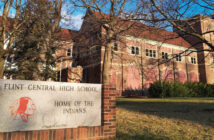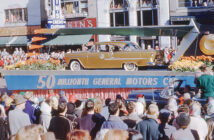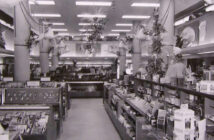The first two installments of this series focused on David Buick and other men who worked to get the Buick Motor Company off the ground at the dawn of the 20th century. Last month, we left off with Durant’s 1904 takeover of Buick. The explosive growth of the company after that takeover is well remembered and well chronicled. This month, we’ll track down the shadow men of Buick and learn their fates.
David Dunbar Buick
David Dunbar Buick had not been enthused about his company’s move to Flint in 1903. He continued to fade in importance in the company that bore his name until 1908. At that time, three shifts of workers had the Buick factories running seven days a week producing 50 cars a day, and Billy Durant’s grandiose dreams were ever expanding. David’s nerves could take no more of the frantic pace, and it’s possible his ego was suffocated by the brilliance of his boss and co-workers. When he left, no one seemed to notice. Buick moved to California and incorporated the Buick Oil Company in 1910. He hit several “gushers” that brought him a great deal of success and high living, but it was transient. Buick Oil was plagued by lawsuits claiming fraud until the company collapsed.
Buick’s subsequent investment in Florida real estate with what was left of his oil money only impoverished him more when the boom collapsed. Shortly thereafter, his first wife, Caroline, passed away. Apparently not defeated, Buick made two feeble attempts to reenter the car market: once in 1921, a venture that resulted in 350 Lorraine automobiles, and again in 1923, but it turned out to be a scam by his venture capitalists. Lawrence R. Gustin, historian and author of multiple books on Buick, said, “He probably jumped too quickly at promotions like the Lorraine and the Dunbar, but he was also desperately poor in an era before the government provided financial safety nets.” The Buicks, once very wealthy, were so poor that they were later evicted from 13 apartments for nonpayment of rent. David lived with his son for a few years until his May-December marriage to Margaret Harrington, more than 40 years his junior. Perhaps his young wife helped ease the wretchedness of self-induced poverty. By 1928, he was working at the information desk of the Detroit School of Trades, “a thin, bent little man, peering through heavy glasses.” He succumbed to pneumonia a year later. His son, Tom, blamed GM for his father’s downfall and refused to ever drive a car again, although it is said that David “the dreamer” did not turn bitter.
Walter Marr
Although Walter Marr’s foray into the auto industry was marked by great turbulence, unlike his compatriot David Buick, Marr’s story is one of unparalleled success. Marr was able to turn his ingenuity into marketable results for Durant to sell in the early years of Buick, especially on the racetrack. In 1909, Buick had reached new heights in both the racing world and in production, but the feverish pace wore on Marr until he was nearly incapacitated with illness. When he was diagnosed with tuberculosis, a terrifying sentence at the time, the Marrs moved to Denver to let Walter rest. While in Denver, Marr took up airplane design to pass the time, a passion he pursued for the rest of his life. In 1910, Marr returned to Flint much better, and continued to design better performing engines, even after his good friend Durant was forced out of GM. His health was evidently fragile, however, as he took several vacations in 1912 and 1913, one to Chattanooga, TN where the habitual insomniac finally got a good night’s rest. In 1914, the Marrs purchased a cottage on Signal Mountain in Chatanooga, named “It Suits Me,” and Walter continued to work as chief engineer, meticulously overseeing every aspect of engine design from this perch until he stepped down in 1917. Marr was a prolific engineer, whose ingenious designs in engines, motors, airplanes, war tanks and carburetors made him very wealthy. He built a large mansion named Marrcrest on Signal Mountain in 1929 and retired that same year. He lived there happily with his wife, receiving many visitors and making occasional visits to Flint until his passing in 1941.
Eugene C. Richard
Eugene Richard was born in Savoy, France in 1867 and had apprenticed with an uncle in a machine shop before immigrating to the U.S. in 1888. He was the third engineer hired by David Buick in Detroit in 1901. Richard filed the patent for the overhead valve engine – the foundation upon which the entire company was built – in 1902. Although Richard did not move with Buick to Flint in 1903 when it was purchased by the Flint Wagon Works, he returned to the auto company in 1908 and filed seven additional patents on its behalf over the years. He became known as the oldest engineer in the Buick factory, and continued to research and work on special projects until around 1930 or 1931 when he fell ill and retired. He died in Flint in 1938 and was interred in Owosso. Not much is known of his personal life except that he was married to Louise Richard and had three children.
Arthur C. Mason
Born in Toronto, Canada in 1870, Arthur Mason worked for Cadillac in Detroit before becoming factory superintendent at Buick. He was one of the first three men hired when Buick moved to Flint in 1903. He is credited with creating the two-cylinder overhead-valve engine of 1904, before Marr and Richard returned. After Billy Durant was forced out of GM for the first time in 1910, Mason partnered with him in 1911 to create the Mason Motor Co., which was intended to build engines for Durant’s other car companies, Little and Chevrolet. Mason Motor Co. consolidated with Chevrolet, of which Mason became vice president. When Durant regained control of GM and merged it with Chevrolet, Mason continued to work as consulting engineer. In 1922, he teamed up with Durant again, who had been ousted from GM for the final time, and organized the Mason Motor Truck Company. A year later, following the venture’s collapse, he retired and moved to California, although he remained on the General Motors advisory board. In 1928, he organized the Sierra Aircraft Company, but it is unclear what ever happened with that endeavor. What is known is that he returned to Flint around 1930 and became plant manager of the Redmond Manufacturing Company. He died that year after a fall down the stairs in his home.
James H. Whiting
James Whiting was older than most of the men responsible for building up Buick Motor Company. He was 61 when the Flint Wagon Works, of which Whiting was president, bought Buick and transferred production to Flint in 1903. Only a year later, as Buick still struggled to get into mass production, Whiting successfully convinced Billy Durant to take over the floundering automobile company. Buick took off thanks to Durant’s salesmanship, but Whiting was apparently still very much interested in the automobile industry, since he decided a few years later to begin assembling his own motor cars. The new Whiting Motor Company, which was never incorporated and instead became the auto department of the Wagon Works, started production of the Whiting 20 in the fall of 1909. Once again, however, Whiting could not sustain his automobile venture alone, and the Flint Wagon Works was sold to Durant on October 12, 1911 for a nominal $10, although management received stock in Durant’s newest endeavors, namely Mason Motor Co., Little Motor Car Company, and Chevrolet. What Whiting did afterward is not known. He died in 1919 at his daughter’s house in New York City, but rests in Flint’s Glenwood Cemetery.







